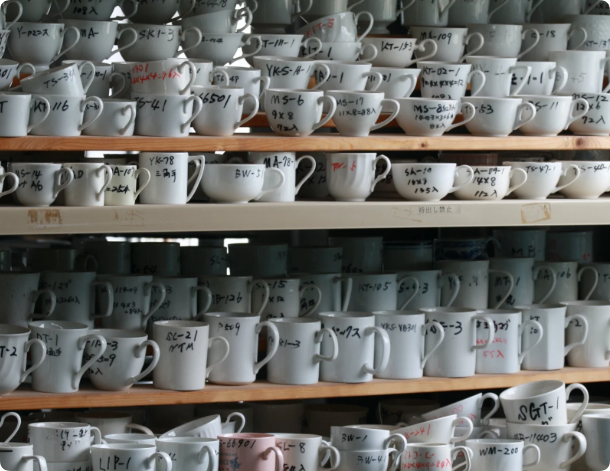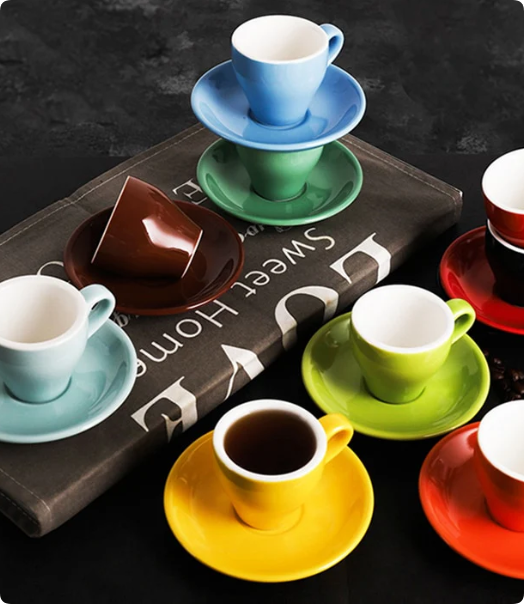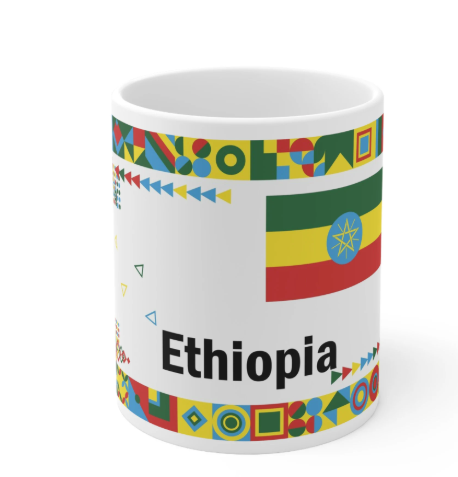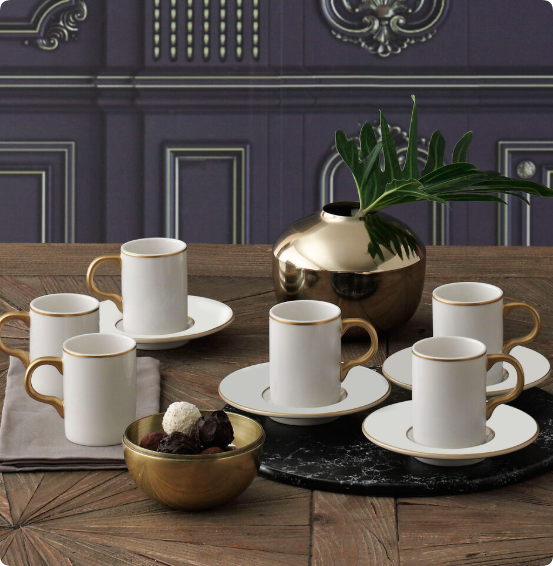Coffee mugs are an essential item in most households and offices, making it crucial for manufacturers to understand which materials perform best in terms of durability, heat retention, and aesthetic appeal. For both retailers and customers, the material of a coffee mug can influence the drinking experience, from flavor preservation to comfort. In this article, we will delve into the best materials for coffee mugs, explore different shapes, sizes, and capacity preferences, and highlight how various countries’ coffee cultures affect the design of ceramic mugs. Additionally, we will take a closer look at EKA’s services, which cater to global kitchenware buyers, gift merchants, and cross-border e-commerce sellers.
The Best Ceramic Materials for Coffee Mugs
When it comes to ceramic mugs, several materials are used to produce high-quality mugs. These materials play a crucial role in the overall functionality, durability, and aesthetics of the mugs. Here are the most popular ceramic materials for coffee mugs:
1. Porcelain
Porcelain is one of the most popular materials for high-end coffee mugs. It is known for its smooth texture, fine finish, and translucent appearance. Porcelain mugs are durable, heat-resistant, and often feature delicate designs. They are commonly used for coffee mugs in upscale cafes or fine dining settings. The porcelain material ensures that the coffee remains hot for a longer period due to its excellent heat retention properties.
2. Stoneware
Stoneware is another excellent option for coffee mugs, known for its rustic and handmade feel. Mugs made from stoneware are typically heavier and thicker than porcelain mugs. This material is also known for its excellent thermal insulation, keeping your coffee hot longer. While stoneware mugs may not have the same fine finish as porcelain, they have a durable, earthy charm that appeals to many coffee enthusiasts.
3. Earthenware
Earthenware mugs are often chosen for their affordability and ease of production. They are made from a blend of clay that is fired at lower temperatures than porcelain or stoneware. While earthenware mugs may not retain heat as well as stoneware or porcelain, they provide a rustic, natural aesthetic that is popular in more casual settings. They are often thick, which can contribute to their durability.
4. Bone China
Bone china is considered one of the most refined ceramic materials, made by adding bone ash to porcelain. It has a delicate, yet durable, feel and is often used for high-end coffee mugs. Bone china mugs are lighter than stoneware or earthenware, making them comfortable to hold. The material’s smooth surface and elegant appearance make bone china a popular choice for premium coffee mugs.
Common Sizes and Capacities of Coffee Mugs
The size and capacity of coffee mugs are essential factors that influence their appeal to different market segments. Coffee drinkers often have preferences based on how much coffee they typically consume or the type of coffee they enjoy. Here are some common sizes and capacities of ceramic coffee mugs:
| Size/Capacity | Description | Popular Use |
|---|---|---|
| 6 oz (177 ml) | Small mugs | Espresso or small servings of coffee |
| 8 oz (237 ml) | Standard mug size | Ideal for a regular cup of coffee |
| 10 oz (296 ml) | Larger than standard size | Good for medium to large servings of coffee |
| 12 oz (355 ml) | Common larger size | Popular for drip coffee, lattes, or cappuccinos |
| 16 oz (473 ml) | Jumbo size | Perfect for those who prefer larger cups of coffee or coffee-based drinks like lattes or Americanos |
As can be seen, the capacity of a coffee mug varies depending on the type of coffee being served. Small espresso mugs typically hold less than 8 oz, while larger mugs can hold up to 16 oz or more, catering to a wider audience of coffee drinkers.
How Coffee Culture Influences Ceramic Mug Designs
Different countries around the world have unique coffee cultures, and these cultural influences can greatly impact the design of ceramic mugs. Some regions have specific preferences for mug shapes, sizes, and designs based on how coffee is traditionally consumed. Below are a few examples of how coffee culture affects mug design:
- Italy: Known for its espresso culture, Italy’s coffee mugs are typically small and espresso-sized (around 6 oz). The design is simple, and mugs are often made from porcelain or ceramic with minimal decoration.
- Turkey: Turkish coffee is traditionally served in small cups known as “fincan,” often with intricate designs or gold details. These cups have a distinct, elegant style that reflects the country’s historical craftsmanship in ceramics.
- United States: In the U.S., coffee mugs are often larger, with sizes ranging from 12 oz to 16 oz. The design is typically simple and functional, but there is a growing trend for quirky or personalized mugs that reflect individual personalities.
- Ethiopia: Ethiopia, the birthplace of coffee, typically serves coffee in small cups (similar to Turkish cups). These cups are often handcrafted, with intricate details or cultural symbols that represent Ethiopia’s rich coffee heritage.
As these examples show, coffee mug designs are influenced by the brewing method and the cultural significance of coffee in each region. For manufacturers, understanding these preferences is key to developing mugs that cater to the unique needs of coffee drinkers around the world.
Common Shapes of Ceramic Coffee Mugs
Ceramic coffee mugs come in a variety of shapes, each serving different purposes and appealing to different consumer preferences. Here are some common mug shapes:

- Standard Cylinder: The most common shape, with straight sides and a handle. This shape is simple, functional, and widely used for everyday coffee mugs.
- Tapered Shape: A design that narrows at the bottom. These mugs are stylish and ergonomic, often used for lattes and other coffee-based drinks.
- Globe Shape: This rounder, bulbous design is popular in cafes and restaurants. It provides a larger surface area to enhance aroma, ideal for coffee enthusiasts who enjoy savoring their brew.
- Travel Mugs: Often made of ceramic with a lid, these mugs are designed for people who need to take their coffee on the go. They come in various shapes, but the most common is a cylindrical or slightly tapered form.
EKA’s Services: Tailored Solutions for Coffee Mug Suppliers
EKA is a leading ceramic manufacturer specializing in high-quality ceramic mugs, along with a range of other ceramic products. EKA provides OEM and ODM services to help businesses customize their mugs to suit their branding needs. Whether you are looking for a small batch of custom-designed mugs or large-scale production, EKA offers flexibility and efficiency. Our services include:
- Design Assistance: EKA’s team of expert designers can assist you in developing unique and appealing designs for your coffee mugs.
- Custom Printing: We offer printing services for logos, patterns, or designs that align with your brand.
- Quality Control: EKA’s commitment to quality ensures that every coffee mug produced meets international standards for durability and safety.
- Packaging Solutions: We provide custom packaging options to ensure your mugs are shipped securely and presented professionally.
- Global Shipping: With a wide network, EKA can supply ceramic mugs to buyers across the globe, including markets in North America, Europe, and Asia.
Conclusion
Choosing the right material for your coffee mugs is essential for ensuring an enjoyable coffee-drinking experience. Whether you are looking for porcelain, stoneware, earthenware, or bone china, each material offers unique benefits. Understanding the cultural influence on coffee mug designs and selecting the correct size and shape is equally important. As a global supplier, EKA offers tailored solutions to meet the diverse needs of coffee mug buyers worldwide, ensuring high-quality, customizable ceramic mugs for every occasion.




